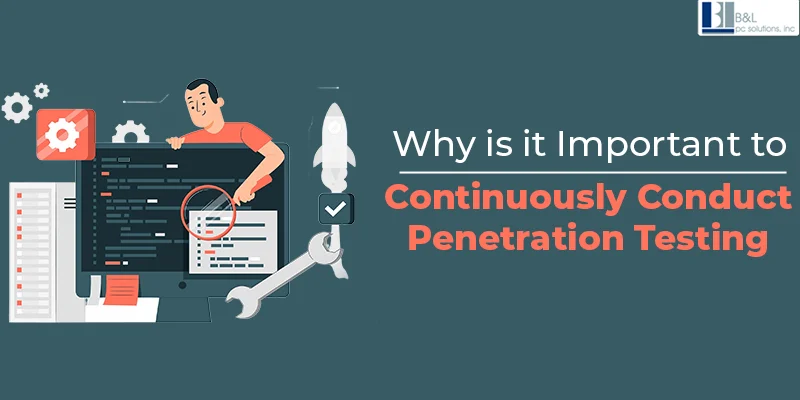
We’re happy to live in a hyperconnected world but here cybersecurity is more than a safety precaution. It is a critical component of an organization's operational integrity. Every organization, large and small, government, and individual agency relies on the complicated systems to manage sensitive data such as financial transactions and other interactions. These enterprises always took the help of IT Managed Service Provider Long Island to tackle their security concerns. However, as these systems get more complex, fraudsters' tactics for exploiting weaknesses evolve.
This is where the process of continuously conducting Penetration testing comes in. This helps the organization identify vulnerabilities that hackers can easily exploit. Let’s discuss why it is essential to constantly conduct penetration testing for a strong security system, how it works, and more.
Understanding Penetration Testing?
Read if you’re new to this cyberworld. Finding and assessing weaknesses inside a system or network before malevolent people take advantage of them is known as penetration testing or ethical hacking. In this testing, expert " white hat” hackers mimic the same attack to test a system's defenses. They mimic similar techniques cybercriminals use, including SQL injections, phishing, etc.
Pen testers assess weaknesses and potential risks and inform the organization of methods to strengthen security measures through tolls or manual testing.
Advantages of Continuously Conduct Penetration Testing
Simple penetration testing or traditional one offers valuable information but is only reliable for the system’s security at a single time. With the evolving cyber threats, security strategy should also grow continuously. The points below answer your question, “Why Is It Important to Continuously Conduct Penetration Testing for a Strong Security System?” Start Reading-
1. Take Action Against Changing Cyberthreats
The strategies, methods, and procedures used by cybercriminals also evolve with technology.. A single or one-time penetration test might miss a new attack vector or a patchable flow that was previously known. Thus, regular and ongoing penetration testing helps identify new and evolving threats before they exploit your system and corrupt your data. New attack methods, like zero-day exploits or novel social engineering attacks, emerge frequently, so these threats are also identified with continuous penetration testing.
2. Addressing Dynamic Systems and Infrastructure Changes
Modern infrastructures are dynamic nowadays. Software updates, hardware improvements, the launch of new apps, or cloud-based services all cause organizations to modify their infrastructures. Every infrastructure modification raises the possibility of additional vulnerabilities; for instance, it may reveal private information or result in an unsafe setup.
Security safeguards are kept current and effective by ongoing penetration testing. Since vulnerabilities are hard to find when they are concealed in new systems or integrations, this aids in testing the system after every minute change in the infrastructure. Thus, regular testing quickly identifies and addresses weaknesses before cyberattacks.
3. Detecting the Full Range of Threats
Threats are not limited to technical flaws. They also include phishing emails, threats in network infrastructure, web applications, social engineering defenses, and physical security. The effectiveness of an organization's personnel and procedures in managing possible breaches is assessed through ongoing penetration testing. To get rid of non-technical risks like insider threats and human mistake, continuous testing is helpful.
4. Regulation and Industry Standards
Regular security via Continuous penetration testing in industries like healthcare, finance, and government is crucial. These are industry standards such as PCI-DSS, HIPAA, and more, not an optional need. These industry standards conduct regular vulnerability assessments and penetration testing.
Continuous penetration testing ensures compliance with all industry regulations and provides an ongoing measure of security health. It also helps industry partners and clients maintain a high-quality security standard. This process can easily avoid costly fines, legal issues, and reputational damage.
5. Lowers the Price and Effect of a Data Breach
A successful hack might have serious financial and reputational consequences. IBM's 2024 Cost of a Data Breach research estimates that the average cost of a data breach in 2024 will be $4.88 million. This cost goes beyond monetary losses and is 10% higher than in 2023. It has a lasting impact on a company's reputation, clientele, and competitive standing.
You can take the help of IT Managed Service Provider Long Island for Continuous penetration testing that can help organizations lower the likelihood of successful attacks. Identifying security issues early protects them from being exploited and reduces total risk to the firm, making it more cost-effective in the long term.
Read More Blog: The Best 7 Hardware Penetration Testing Tools in 2025
6. Changing with the Times and Cybersecurity Trends
New attack surfaces and risks are brought about by emerging technology. For example, the extensive usage of cloud computing, IoT devices, and AI-driven apps has greatly increased the amount of possible vulnerabilities in contemporary networks. A complete system may no longer be secure with a single-layer security technique.
Security teams may take a more proactive approach to evaluating these new technologies as they are included in the system by using continuous penetration testing. The attack surface changes and new vulnerabilities are produced with each new technological advancement. Regular penetration testing enables organizations to identify emerging risks and take proper action.
7. Establishing a Strong Incident Response Plan
Reducing damage requires an efficient incident response (IR) plan when a security breach happens. Your team will be better equipped to handle all threats if you do regular penetration testing. Security teams may train and improve their response methods by simulating different attack scenarios, which will help them contain and remediate problems more rapidly.
Furthermore, the existing incident response method has vulnerabilities that are discovered through continuous testing. It assists security teams in assessing the success of their present tactics and identifying areas for improvement to improve the organization's capacity to identify, respond to, and recover from attacks.
Read More Blog: Easy Steps To Setup Homelab to Practice Penetration Testing
Summing Up Words
An organization's security infrastructure is continuously invested in through penetration testing, which is not a one-time practice. Continuous testing helps guarantee that the organization's defenses remain effective and that security measures adjust to new threats as the environment changes.
Regular vulnerability reviews help organizations manage new threats, and keep a proactive security framework. This also lessens the financial effects of data breaches and makes sure industry regulations are followed. Using IT Services Long Island to conduct ongoing penetration testing is a smart option in an era when cybercrime is on the rise and the cost of a breach is higher than ever. It is a crucial strategy for keeping a robust and long-lasting security system.
Read More Blog: Top 11 Penetration Testing Tools in 2025
Security-Related Questions Asked
1. How Does Continuous Penetration Testing Differ From Conventional Penetration Testing?
The times of conduction are the primary difference. While continuous testing is done routinely and helps to guarantee vulnerabilities are discovered and fixed as they arise, keeping up with developing threats, traditional penetration testing is usually done once or twice a year.
2. Is It Possible For Continuous Penetration Testing To Replace Extra Security Measures?
Regular penetration testing improves security features including intrusion detection systems, firewalls, and antivirus programs. It helps enhance the security architecture and finds flaws these tools might overlook.
3. How Much Does Ongoing Penetration Testing Cost?
Continuous penetration testing with the help of Managed IT Services Long Island may save money over time by averting expensive data breaches, legal expenses, and compliance fines, even if the initial setup and monitoring appear costly. Numerous suppliers provide scalable solutions adapted to a company's requirements and scale.
4. How Frequently Should Vulnerabilities Be Fixed In a System That Uses Continuous Penetration Testing?
If the system is using continuous penetration testing, vulnerabilities will be fixed as soon as it is identified. It is advised to fix critical vulnerabilities while low priority issues can be delayed and other picked up based on their importance and effect.
Tags: Advantages of Penetration Testing, Benefits of Penetration Testing, Continuous Penetration Testing, Continuously Conduct Penetration Testing, penetration testing, Who Conducts Penetration Testing?





